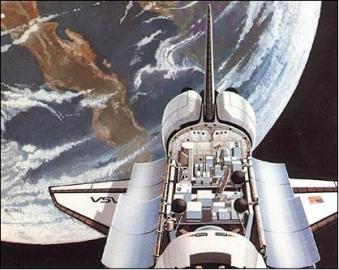
The Atlas Program
ATLAS-1, the first of the ATLAS series of Shuttle flights, was an important part of the long-term, coordinated research that made up NASA's Mission to Planet Earth. The ATLAS-1 solar science instruments and several of the atmospheric science instruments (MAS, ATMOS and SSBUV) flew on future ATLAS missions. Beyond its own science mission, a key goal of the ATLAS series was to provide calibration for NASA's Upper Atmosphere Research Satellite (UARS), launched from the Space Shuttle in September 1991. Two ATLAS-1 instruments, ACR and SUSIM, have direct counterparts aboard UARS, while other instruments aboard each mission were closely related. Repeated flights of the ATLAS instruments, which can be carefully calibrated before and after each flight, will allow for long-term calibration of UARS instruments.
This was the first of a series studying the Earth's atmosphere and the Sun's influence upon it over an entire 11-year solar cycle. ATLAS-1 experiments focused on four scientific disciplines: atmospheric science, solar science, space plasma physics and astronomy. By making simultaneous solar and atmospheric measurements on a global scale, scientists hope to unravel the complicated web of man's impact on the environment.
ATLAS-1 payloads
NASA's Atmospheric Trace Molecule Spectroscopy instrument and the Grille Spectrometer from Belgium, mapped trace molecules in the middle atmosphere during orbital "sunrises" and "sunsets,".
Atmospheric Lyman-Alpha Emmissions instrument, developed by scientists in France and Belgium, measured common hydrogen and deuterium, or heavy hydrogen.
The Millimeter-Wave Atmospheric Sounder (MAS) was a collaborative effort of Germany, Switzerland and the United States, and measured ozone, chlorine monoxide, water vapor, temperature and pressure in the middle atmosphere.
The Shuttle Solar Backscatter Ultraviolet Experiment, whose measurements were used to calibrate ozone-measuring instruments.
Participants: Other countries participating in experiments on the ATLAS-1 payload are; Belgium, France, Germany, Japan, the Netherlands, Switzerland and the United Kingdom.
The European Space Agency provided operational support for the European investigations.
ATLAS-2 payloads
The primary payload of the flight was the Atmospheric Laboratory for Applications and Science-2 (ATLAS-2), designed to collect data on relationship between sun's energy output and Earth's middle atmosphere and how these factors affect ozone layer. Included six instruments mounted on Spacelab pallet in cargo bay, with seventh mounted on wall of bay in two Get Away Special canisters. Atmospheric instruments were Atmospheric Trace Molecule Spectroscopy (ATMOS) experiment; Millimeter Wave Atmospheric Sounder (MAS); and Shuttle Solar Backscatter Ultraviolet/A (SSBUV/A) spectrometer (on cargo bay wall). Solar science instruments were Solar Spectrum Measurement (SOLSPEC) instrument; Solar Ultraviolet Irradiance Monitor (SUSIM); and Active Cavity Radiometer (ACR) and Solar Constant (SOLCON) experiments.
ATLAS-2 is one element of NASA's Mission to Planet Earth program. All seven ATLAS-2 instruments first flew on ATLAS-I during STS-45, and will fly a third time in late 1994.
ATLAS-3 payloads
The third flight of ATLAS focused on atmospheric and solar physics and consisted of the same experments as in ATLAS-2 with the addition of two co-manifested experiments. The ATLAS-3 instruments were mounted on Spacelab pallets in the Shuttle payload bay. The Shuttle's changing orientation to Earth placed the experiments in advantageous orbiting locations to observe the atmosphere and the Sun. The Shuttle orbiter orientation was either inertially fixed so that the selected instruments were pointed at the Sun, or nadir pointed for observations of the Earth's atmosphere. Crew members were in consultation with the investigators while controlling and monitoring the experiments. The ATLAS-3 core instruments consisted of: (1) Active Cavity Radiometer Irradiance Monitor (ACRIM); (2) Measurement of the Solar Constant (SOLCON); (3) Solar Spectrum Measurement (SOLSPEC); (4) Solar Ultraviolet Spectral Irradiance Monitor (SUSIM); (5) Atmospheric Trace Molecule Spectroscopy (ATMOS); and (6) Millimeter-Wave Atmospheric Sounder (MAS). The ATLAS-3 payload was co-manifested with the 6th flight of the Shuttle Solar Backscatter Ultraviolet (SSBUV-06) experiment, the German Space Agency (DARA) Shuttle Pallet Satellite/Cryogenic Infrared Spectrometers and Telescopes for the Atmosphere (SPAS/CRISTA) from Germany, and the Middle Atmospheric High Resolution Spectrograph Investigation (MAHRSI) from the Naval Research Laboratory (NRL). Both MAHRSI and CRISTA were mounted on the German SPAS carrier and were integrated into the ATLAS-3 science plan.

